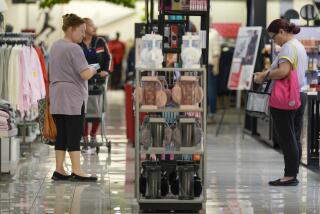Economy Grows at Anemic 1.7% in 2nd Quarter
- Share via
WASHINGTON — The economy continued to stagger in the second quarter, growing at an anemic 1.7% annual rate, the government said Thursday in its preliminary report on the nation’s gross national product during that period.
For the entire first half of the year, economic output advanced at only a 1% rate, as the nation’s huge trade imbalance dragged down growth and the accumulation of business inventories dropped sharply. But personal consumption remained strong and business investment picked up speed in the second quarter, leaving puzzled analysts more divided than ever over the direction of the economy.
“The economy is showing some real anomalies that make projecting the future very, very uncertain,” said Robert Parry, chief economist at Security Pacific National Bank in Los Angeles. “I wouldn’t be surprised to see a major rebound in the third quarter,” he added, “but I’m not prepared to put that in my forecast yet.”
In contrast, John Makin, director of fiscal policy research at the conservative American Enterprise Institute, predicted: “We will see slow growth for the rest of the year. The Fed has been pushing money out the window, but the economy is simply not responding. That has a lot of people worried.”
Commerce Secretary Malcolm Baldrige conceded that the latest GNP figures, which will undergo at least two revisions, show that the economy will not meet the Administration’s 3.9% growth target for the year, forcing a revision next month that will increase the White House’s projected $220-billion federal deficit for this fiscal year. Slower growth adds to the deficit by reducing the revenues the government receives from business profits.
Baldrige Optimistic
Although he refused to predict what the revised forecast would be, Baldrige said that he remains optimistic that the economy will improve in the second half.
The performance during the April-June period was not as bad as the nearly flat 0.3% growth of the first quarter, but it was well short of the initial “flash” estimate of a 3.1% gain in the second quarter. All the figures are adjusted for inflation.
In a breakdown of the intense secrecy that surrounds the GNP statistics, the report leaked out to Wall Street on Wednesday afternoon, well before it was made public Thursday morning, Commerce Department officials acknowledged. Baldrige disclosed that someone outside the government telephoned department analysts with the correct figures and admitted that the advance information could influence financial markets.
Bond prices, which normally rise on evidence of weakness in the economy because investors expect interest rates to drop, fell sharply Thursday after the official GNP report was released.
The picture was clouded, however, because Federal Reserve Chairman Paul A. Volcker, who has been presenting his semiannual report to Congress over the last three days, told the Senate Banking Committee that he was more impressed by the evidence of strong domestic demand than by the overall weakness in the economy.
In another report Thursday, the Federal Reserve said that industrial production rose a slight 0.1% in June, matching the May increase and providing further evidence of the difficulties that the nation’s heavy manufacturing and mining firms face from foreign competitors.
Dollar’s Value Falls
Even though the U.S. dollar has recently fallen from its peak levels of earlier this year, eventually making American products more competitive in world markets, imports are still capturing a growing share of the still-robust U.S. market.
And, although the strong dollar has encouraged a flow of inexpensive imports, undercutting U.S. economic growth, it has also helped hold down prices by forcing American firms to cut costs. Inflation, as measured by one GNP-related index, was up a modest 3.8% in the second quarter, compared to 4.3% during the first period.
With inflation still under control and consumer confidence remaining high, nearly all analysts are convinced that the economy is in little danger of falling into a recession in the near future.
Nonetheless, many economists were discouraged by the further erosion in foreign trade, with exports declining at a rate of 12.5% while imports continued to rise at a 1.4% rate. Overall, net exports of goods and services, adjusted for inflation, fell an additional $5.4 billion in the second quarter on top of a $15-billion decline in the first three months of the year.
“At this point, the factors dragging down the economy are more powerful than those pushing it up,” Jerry Jasinowski, chief economist at the National Assn. of Manufacturers, said. “A general liquidation of inventories and the massive trade deficit have outweighed consumer demand and capital spending, which have held up reasonably well.”
Stronger Growth Seen
But other economists believe that the decline in inventory investment, which knocked $13.3 billion off the second-quarter GNP figures, will set the stage for stronger growth later this year. That is because businesses eventually will be forced to rebuild their inventories to keep up with consumer demand, providing a strong boost to any future economic rebound.
“Fundamentally, the economy is not in bad shape and, if consumer spending holds up, we should see a rebound by the fourth quarter,” Robert Gough, an economist at Data Resources in Lexington, Mass., said. “Our ability to buy is still quite good. It is just the trade imbalance that is allowing much of that strength to leak overseas.”
Indeed, the GNP report showed that final sales, which measure business and consumer spending, advanced at a strong 5.1% rate in the second quarter, fed by a 5.2% increase in personal consumption and a 13.6% gain in investment in commercial buildings, factories and production equipment.
More to Read
Inside the business of entertainment
The Wide Shot brings you news, analysis and insights on everything from streaming wars to production — and what it all means for the future.
You may occasionally receive promotional content from the Los Angeles Times.










